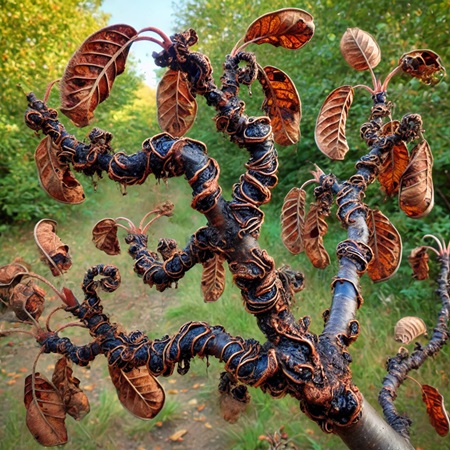Fire blight is a destructive bacterial disease that affects a wide variety of trees, especially those in the rose family, such as apple, pear, hawthorn, and quince. Caused by the bacterium Erwinia amylovora, fire blight can spread rapidly, especially in warm, wet weather, causing significant damage to orchards and landscapes. Identifying and treating fire blight early can help limit its spread and protect your trees from severe damage. Here’s how to recognize the disease and manage it effectively.
Identifying Fire Blight Disease
Wilting and Browning of Branches
One of the most distinctive symptoms of fire blight is the sudden wilting and browning of flowers, leaves, and twigs. The affected parts of the tree look scorched, as though they have been burned by fire—hence the name “fire blight.” The infected leaves usually remain attached to the tree throughout the growing season, even though they are dead and brown.

Shepherd’s Crook Symptom
As the disease progresses, the ends of twigs and branches may bend into a characteristic shape resembling a shepherd’s crook. This symptom is a telltale sign of fire blight and is often the first sign that homeowners or gardeners notice.
Oozing Lesions
Fire blight bacteria cause cankers (dead, sunken areas) on branches, stems, and the trunk. During wet or humid conditions, these cankers may ooze a sticky, milky substance that contains the bacteria. This ooze can appear white, amber, or red, depending on the tree species and environmental conditions.
Fruit Symptoms
Infected fruits can become discolored, shriveled, and misshapen. These fruits may remain attached to the tree and serve as a reservoir for the bacteria, further spreading the disease.
Rapid Spread
Fire blight can spread quickly through a tree, especially during periods of warm, rainy, or humid weather. In severe cases, entire limbs can die off within a few weeks.
Trees Susceptible to Fire Blight
The following trees are particularly susceptible to fire blight:
- Apple (Malus)
- Pear (Pyrus)
- Quince (Cydonia)
- Hawthorn (Crataegus)
- Crabapple (Malus sylvestris)
- Serviceberry (Amelanchier)
- Mountain ash (Sorbus)
Fire blight is a common concern for commercial orchards but can also affect ornamental trees in residential landscapes.
Treating Fire Blight Disease
Prune Affected Areas
The most effective way to manage fire blight is to prune and remove infected branches as soon as symptoms appear. When pruning, make cuts at least 12 inches (30 cm) below any visible symptoms to ensure you remove all infected tissue. Disinfect pruning tools between cuts using a solution of bleach (1 part bleach to 9 parts water) or alcohol to prevent spreading the bacteria.
Timing is important—prune during dry weather to reduce the risk of spreading the disease through moisture. Avoid heavy pruning in the spring when the bacteria are most active, as this can encourage further infection.
Remove Infected Trees or Limbs
In severe cases where the infection has spread extensively, removing the entire tree may be necessary. This is particularly important for young trees or highly susceptible varieties. Be sure to remove all plant debris from the area, as the bacteria can survive on dead tissue and spread to other plants.
Apply Copper-Based Sprays
Copper-based fungicides or bactericides can help suppress fire blight infections when applied correctly. Spraying during bloom time—when the bacteria are most likely to infect through blossoms—can reduce the risk of infection. However, be cautious with copper sprays, as overuse or incorrect application can cause damage to the tree, especially on sensitive species.
Follow the label instructions carefully and consider applying during cooler temperatures to avoid leaf burn. Copper sprays are often more effective when used in combination with other management practices, like pruning and sanitation.
Use Biological Controls
Some biological controls, such as beneficial bacteria, can help protect trees from fire blight. These products contain strains of bacteria that compete with Erwinia amylovora, reducing its ability to infect trees. Biological controls can be applied as a preventive treatment during the bloom period.
Resistant Varieties
If fire blight is a recurring problem, consider planting resistant varieties of trees. Many apple and pear varieties have been bred for resistance to fire blight, reducing the risk of infection and minimizing the need for chemical treatments. Resistant varieties may still become infected, but the severity of the disease is typically much lower than in susceptible varieties.
Preventing Future Fire Blight Infections
Proper Plant Spacing
When planting new trees, ensure they are spaced properly to allow good air circulation. Crowded trees create a humid environment that favors the spread of fire blight. Good airflow reduces moisture buildup on leaves, flowers, and fruits, helping to keep the disease at bay.
Avoid Excessive Nitrogen Fertilization
High levels of nitrogen promote lush, succulent growth, which is particularly susceptible to fire blight infection. To reduce the risk of infection, avoid over-fertilizing trees, especially during the growing season. Use a balanced fertilizer and follow soil test recommendations for your trees’ specific nutrient needs.
Monitor for Insects
Some insects, such as aphids and leafhoppers, can transmit fire blight bacteria from infected to healthy trees. Controlling these insects with appropriate treatments can reduce the spread of the disease.
Regular Monitoring
Regularly inspect your trees for symptoms of fire blight, especially during the spring bloom period when the disease is most active. Early detection allows for quick intervention, reducing the potential damage.
Conclusion
Fire blight is a serious disease that can devastate susceptible trees if not managed promptly. By recognizing the symptoms early and taking preventive measures like pruning infected branches, applying copper sprays, and selecting resistant tree varieties, you can effectively protect your trees from fire blight. Regular monitoring and proper cultural practices will help keep this bacterial disease under control, ensuring your trees stay healthy and productive for years to come.



Comment here